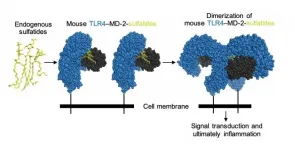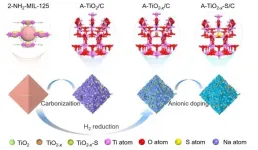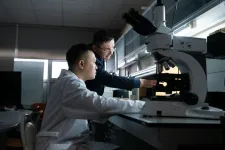(Press-News.org) Scientists have completed the largest and most diverse genetic study of type 1 diabetes ever undertaken, identifying new drug targets to treat a condition that affects 1.3 million American adults.
Several potential drugs are already in the pipeline. Drugs targeting 12 genes identified in the diabetes study have been tested or are being tested in clinical trials for autoimmune diseases. That could accelerate the drugs' repurposing for treating or preventing type 1 diabetes, the researchers say.
"This work represents the largest, most ancesty-diverse study of type 1 diabetes that identifies the most likely causal genetic variants associated with risk, their target genes and those genes that are implicated in other autoimmune diseases with known drug targets," said researcher Stephen S. Rich, PhD, of the University of Virginia School of Medicine and its Center for Public Health Genomics. "Using these results, we hope that the number of plausible genetic variants will be reduced, their function and gene targets clarified, and existing drugs used in other diseases can be tested for their impact on delaying onset of type 1 diabetes, or improved treatment outcomes."
About Type 1 Diabetes
Formerly known as juvenile diabetes, type 1 diabetes can affect both children and adults. In type 1 diabetes, the body's own immune system attacks the insulin-producing beta-cells in the pancreas, such that the body doesn't make enough insulin, a hormone that helps the body burn sugar as fuel. Treatment is insulin replacement, but it is not a cure.
Type 1 diabetes increases the risk for heart problems, stroke, nerve damage and vision loss, and can even cause pregnancy complications and miscarriages. It also reduces blood flow to the feet, meaning that small injuries left untreated can become serious problems, possibly requiring amputation.
The new type 1 diabetes study examined 61,427 participants, which is twice the size of the previous largest study. Most prior research has focused on type 1 diabetes risk in people of European ancestry, while the new findings provide important insights about the type 1 diabetes "genetic landscape" in people of African, Asian and other backgrounds as well, the researchers report in a new scientific paper.
"Increasing diversity in all aspects of research is ethically important but, in addition, diverse populations potentially provide unique genetic insights that can reduce the number of putatively causal variants on risk, as well as interactions with novel non-genetic risk factors," said Rich, of UVA's Department of Public Health Sciences. "For example, in African-ancestry populations, there is evidence in some genomic regions the type 1 diabetes risk variants have narrowed the list of causal variants, while in other regions, the risk variants are distinct from those in European-ancestry populations. These data are critical for implementing genetic risk scores for identifying those children at high genetic risk for future screening and entry into immune-intervention trials."
New Diabetes Findings
In total, the scientists identified 78 regions on our chromosomes where genes are located that influence our risk for type 1 diabetes. Of those, 36 regions were previously unknown.
In addition, the researchers identified specific, naturally occurring gene variations that influence risk, and determined how those variations act on particular types of cells. They were then able to use their findings to identify and prioritize potential drug targets.
Among the potential targets are a dozen examined in current or completed clinical trials for autoimmune diseases. For example, the gene IL23A has been successfully targeted in the treatment of inflammatory bowel disease and psoriasis. Targeting this gene may also prove useful in the battle against type 1 diabetes, the researchers believe.
While more study is needed, the scientists' work has broadened our understanding of type 1 diabetes in different groups and produced many promising leads that could ultimately benefit patients.
"Based upon this work, we are now approaching knowledge of almost 90% of the genetic risk for type 1 diabetes, which is about one-half of the total risk for the disease," Rich said. "This work moves us closer to the goal of precision medicine in type 1 diabetes, when we can use genetics to help identify those at risk for autoantibody screening and early detection, with genetic insights to therapies that would enhance the search for a cure."
INFORMATION:
Findings Published
The researchers have published their findings in the scientific journal Nature Genetics. The research team consisted of Catherine C. Robertson, Jamie R.J. Inshaw, Suna Onengut-Gumuscu, Wei-Min Chen, David Flores Santa Cruz, Hanzhi Yang, Antony J. Cutler, Daniel J. M. Crouch, Emily Farber, S. Louis Bridges Jr., Jeffrey C. Edberg, Robert P. Kimberly, Jane H. Buckner, Panos Deloukas, Jasmin Divers, Dana Dabelea, Jean M. Lawrence, Santica Marcovina, Amy S. Shah, Carla J. Greenbaum, Mark A. Atkinson, Peter K. Gregersen, Jorge R. Oksenberg, Flemming Pociot, Marian J. Rewers, Andrea K. Steck, David B. Dunger, Type 1 Diabetes Genetics Consortium, Linda S. Wicker, Patrick Concannon, John A. Todd and Rich.
The research was supported by the National Institute of Diabetes and Digestive and Kidney Diseases (including grants U01 DK062418, DP3 DK111906, R01 DK1115694), the JDRF (4-SRA-2017-473-A-A), and the Centers for Disease Control, among many others. A full list is included in the paper.
To keep up with the latest medical research news from UVA, subscribe to the Making of Medicine blog at http://makingofmedicine.virginia.edu.
DALLAS - July 20, 2021 - UT Southwestern researchers report the first structural confirmation that endogenous - or self-made - molecules can set off innate immunity in mammals via a pair of immune cell proteins called the TLR4?MD-2 receptor complex. The work has wide-ranging implications for finding ways to treat and possibly prevent autoimmune diseases such as multiple sclerosis and antiphospholipid syndrome.
The TLR4?MD-2 receptor complex is well known for its role in the body's response to infection by gram-negative bacteria. Its role in autoimmunity had been long suspected, although direct proof was lacking. The team, led by Nobel Laureate Bruce Beutler, M.D., director of the Center for the Genetics of Host Defense (CGHD), identified lipids called sulfatides ...
In one out of every six local authorities, rates of hunger are more than 150 per cent (one and a half times) the national average. Shockingly, in one in 10 local authorities, the rate is almost double, according to new research by the University of Sheffield.
Researchers at the University of Sheffield Institute for Sustainable Food modelled data from the Food Foundation, who surveyed people across the UK, and for the first time were able to identify food insecurity at a local authority scale. Local authority percentages show the marked variation in levels of food insecurity between local areas and, whereas national ...
Persistence may be the key when quitting smoking using an electronic nicotine delivery system (ENDS), commonly known as vaping, a University of Otago study found.
Researchers found people attempting to switch from cigarettes to ENDS reported highly varied smoking and ENDS use. They recommend people persist in their attempts to transition away from smoking, even if their progress feels slow and uncertain.
Lead author Associate Professor Tamlin Conner, of the Department of Psychology, says, although people may plan to use ENDS exclusively instead of cigarettes, making the switch is not always straightforward.
"We found that dual use of ENDS and cigarettes was very common, suggesting that people ...
A new quantitative study suggests people seeking asylum are more likely to experience mental health deterioration as they spend more time living in refugee camps, backing up qualitative evidence from aid organisations.
The research, co-authored by Dr Francisco Urzua from the Business School (formerly Cass) alongside practitioners from Moria Medical Support (MMS) and academics from Universidad del Desarrollo, Chile and University of Amsterdam, the Netherlands measured incidences of acute mental health crises arising from extended stays in the Moria refugee camp on ...
Researchers from the School of Biomedical Engineering & Imaging Sciences at King's College London have automated brain MRI image labelling, needed to teach machine learning image recognition models, by deriving important labels from radiology reports and accurately assigning them to the corresponding MRI examinations. Now, more than 100,00 MRI examinations can be labelled in less than half an hour.
Published in European Radiology, this is the first study allowing researchers to label complex MRI image datasets at scale.
The researchers say it would take years to manually perform labelling of more than 100,000 MRI examinations.
Deep learning typically requires tens of thousands of labelled images to ...
Scientists have developed a 'nanobody' - a small fragment of a llama antibody - that is capable of chasing out human cytomegalovirus (HCMV) as it hides away from the immune system. This then enables immune cells to seek out and destroy this potentially deadly virus.
Around four out of five people in the UK are thought to be infected with HCMV, and in developing countries this can be as high as 95%. For the majority of people, the virus remains dormant, hidden away inside white blood cells, where it can remain undisturbed and undetected for decades. ...
The research team of Prof. Xiaobo Ji and associate Prof. Guoqiang Zou has proposed an ingenious oxygen vacancy (OV)-engineering strategy to realize high content anionic doping in TiO2 and offered valuable insights into devise electrode materials with fast charge transfer kinetics in the bulk phase. The article titled "High content anion (S/Se/P) doping assisted by defect engineering with fast charge transfer kinetics for high-performance sodium ion capacitors" is published in Science Bulletin. Xinglan Deng is listed as first author and Prof. Guoqiang Zou as corresponding author.
The ...
An international research team has come up with an innovative method for metal recovery from industrial waste. The new method allows the simultaneous recovery of multiple metals from waste oxides in a single process. This novel route will lower the burden on waste storage facilities with significant contributions to the economic and environmental sustainability of industrial waste management. The study was published in Journal of Environmental Management. This work is the first in a series of studies aimed at developing cost-effective and environmentally sustainable solutions for industrial waste recycling.
Some of the major industries ...
Using the Atacama Large Millimetre/submillimeter Array (ALMA), in which the European Southern Observatory (ESO) is a partner, astronomers have unambiguously detected the presence of a disc around a planet outside our Solar System for the first time. The observations will shed new light on how moons and planets form in young stellar systems.
"Our work presents a clear detection of a disc in which satellites could be forming," says Myriam Benisty, a researcher at the University of Grenoble, France, and at the University of Chile, who led the new research published today in The Astrophysical Journal Letters. "Our ALMA observations were obtained at such exquisite resolution that we could clearly identify ...
Cambridge, MA ¬- Astronomers at the Center for Astrophysics | Harvard & Smithsonian have helped detect the clear presence of a moon-forming region around an exoplanet -- a planet outside of our Solar System. The new observations, published Thursday in The Astrophysical Journal Letters, may shed light on how moons and planets form in young stellar systems.
The detected region is known as a circumplanetary disk, a ring-shaped area surrounding a planet where moons and other satellites may form. The observed disk surrounds exoplanet PDS 70c, one of two giant, Jupiter-like planets orbiting a star nearly 400 light-years away. Astronomers had found hints of a "moon-forming" disk around this exoplanet before but since ...





